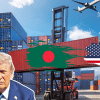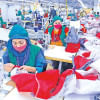Strategies we can employ in tariff talks with the US

The United States has announced that as of August 1, 2025, it will impose an additional tariff of 35 percent on goods imported from Bangladesh. The US President Donald Trump has communicated this decision in a letter to the chief adviser of the interim government, Prof Muhammad Yunus. This happened while the Bangladesh-US tariff negotiations were still on. The letter hinted that if Bangladesh further opens up its markets to US goods and services by removing tariff and non-tariff barriers, the US may reconsider some of the issues raised in the letter. The recently announced tariff rate of 35 percent is lower than the originally announced 37 percent. However, given that the existing average tariff for Bangladesh is already 15 percent, with a 35 percent increase, the effective tariff rate for Bangladesh will be 50 percent.
Such a high US tariff on products from Bangladesh will significantly impact the Bangladesh economy. The US is the single largest market for goods exported from Bangladesh. During the 2024-25 fiscal year, Bangladesh exported $8.4 billion worth of goods to the US market, which represents 18 percent of the total Bangladeshi goods exports. About 2,377 manufacturing houses were associated with export to the US market. The US announcement of a tariff increase may put more than 800 exporting units under serious existential risk. It is feared that the announced tariff increase by the US may adversely impact Bangladesh's macroeconomy significantly.
In Bangladesh, more than 87 percent of the goods exports are RMG, and about 1,821 manufacturing units export these goods. It is a major source of foreign exchange earnings for the country. Bangladesh has been earning more than $4 billion from RMG exports every year since 2000. The sector employs more than four million workers, 80 percent of whom are women. Therefore, with the announced tariff hikes, foreign exchange earnings from RMG exports may go down. It may also lead to job cuts in the RMG sector, as some of the production units will face closures. It goes without saying that the smaller factories will bear the brunt of the adverse impacts of the tariff hikes, and the female workers may be the worst victims of factory closure. The latter will have wider socio-economic and cultural dimensions.
In global RMG exports, Bangladesh holds the second position, next to China. But Vietnam has already emerged as a strong competitor of Bangladesh in RMG exports. Since the US has imposed only 20 percent tariffs on Vietnamese goods, naturally, Bangladesh may lose a large part of the US RMG market to Vietnam.
This raises several questions. For example, the issue of higher tariff rates has been talked about since last April. What could Bangladesh have done to lower the tariff rate to the level of that of Vietnam? Did we not understand the importance of the issue, or did we not have enough preparations to tackle it? Also, did we fail to foresee that such things could happen?
Different quarters have diverse views on these questions, from which five strands of thought can be synthesised. One, the government did not approach the problem with the importance or with the level of consideration this multidimensional issue deserves. There was also a lack of strategic thinking. Many observed that government officials were engaged in the process in isolated manners, and coordinated efforts were absent. Two, the private sector was allegedly kept in the dark and was not included in the process of negotiations. Similarly, lobbyists, who often play a critical part in such negotiations, were not employed. Three, many experts have expressed concerns about whether Bangladesh has fully realised the political dimensions of the tariff issue and its importance in the tariff war. For example, the US has been putting additional pressure on countries that have huge Chinese investments in their territories or have stronger ties with China. Perhaps this factor has worked against Bangladesh in realising additional benefits from the US.
However, there is still time for further negotiations, and if that opportunity is used efficiently and effectively, some additional benefits may be realised in the context of the increased US tariffs. Some points are important in that respect.
First, Bangladesh must understand the US position. For example, we must realise that the new US administration will no longer accept the structure of the World Trade Organization (WTO) and respect the accepted rules and regulations of international trade. Therefore, to raise those issues in trade negotiations with the US is meaningless. Bangladesh must assess what the real outlook and motives of the US are and formulate its trade negotiations strategy accordingly.
Second, since the US has been talking about reducing its trade deficits, Bangladesh may explore which US products we can potentially import in higher quantities. The country has already put some proposals in that respect, which may be re-evaluated. The mutual negotiations must also focus on the potential tariff benefits that Bangladesh may get if it provides some trade benefits to the US. Lobbyists may be employed to move this agenda forward.
Third, we must realise that the US has started the tariff war with a political agenda. We must find out that, in the context of that agenda, what considerations and outlook the US holds for Bangladesh. Those issues must be brought to the discussion table, as politics plays a role along with trade benefits. Both Cambodia and Vietnam have used it to get tariff exemptions.
Fourth, in trade negotiations, the importance of alliances with other countries can hardly be overemphasised. Negotiations may be bilateral, but positions taken must be collective.
Finally, more Bangladeshis, who have expertise in international negotiations and are familiar with the processes of trade deals, should be brought to the negotiation table. Such discussions and negotiations have a particular verbal and body language. Familiarity with those and using them in the Bangladesh-US tariff and trade negotiations is essential. Efficient and effective use of these trade negotiation strategies is likely to help Bangladesh realise additional benefits in tariff talks with the US.
Selim Jahan is former director of the Human Development Report Office under the United Nations Development Programme (UNDP) and lead author of the Human Development Report.
Views expressed in this article are the author's own.
Follow The Daily Star Opinion on Facebook for the latest opinions, commentaries and analyses by experts and professionals. To contribute your article or letter to The Daily Star Opinion, see our guidelines for submission.

 For all latest news, follow The Daily Star's Google News channel.
For all latest news, follow The Daily Star's Google News channel. 







Comments